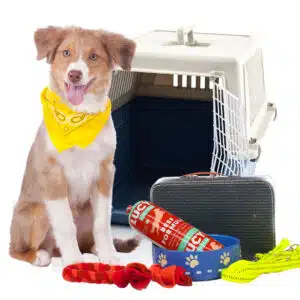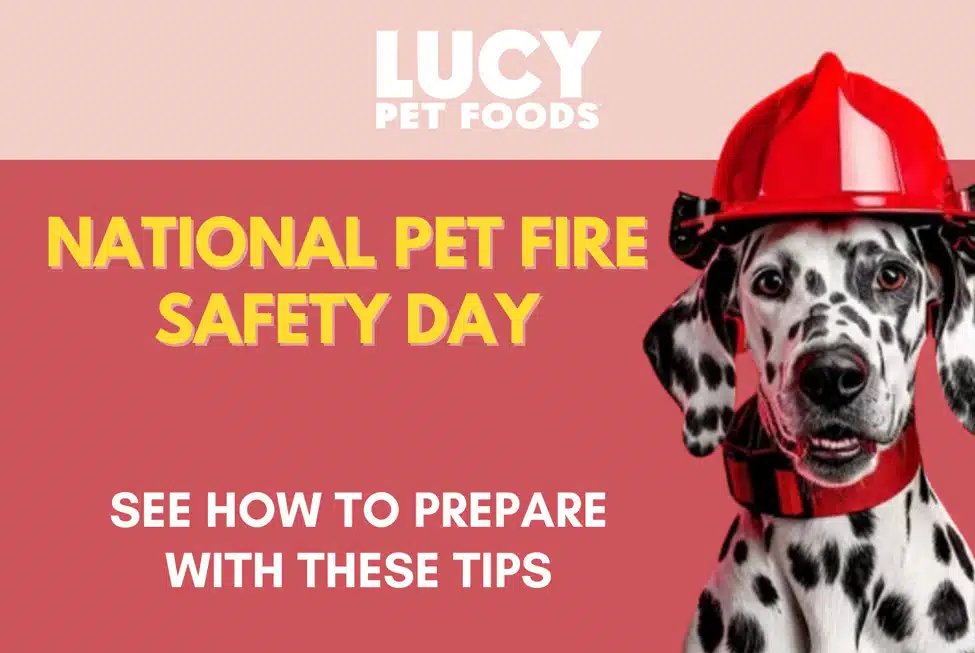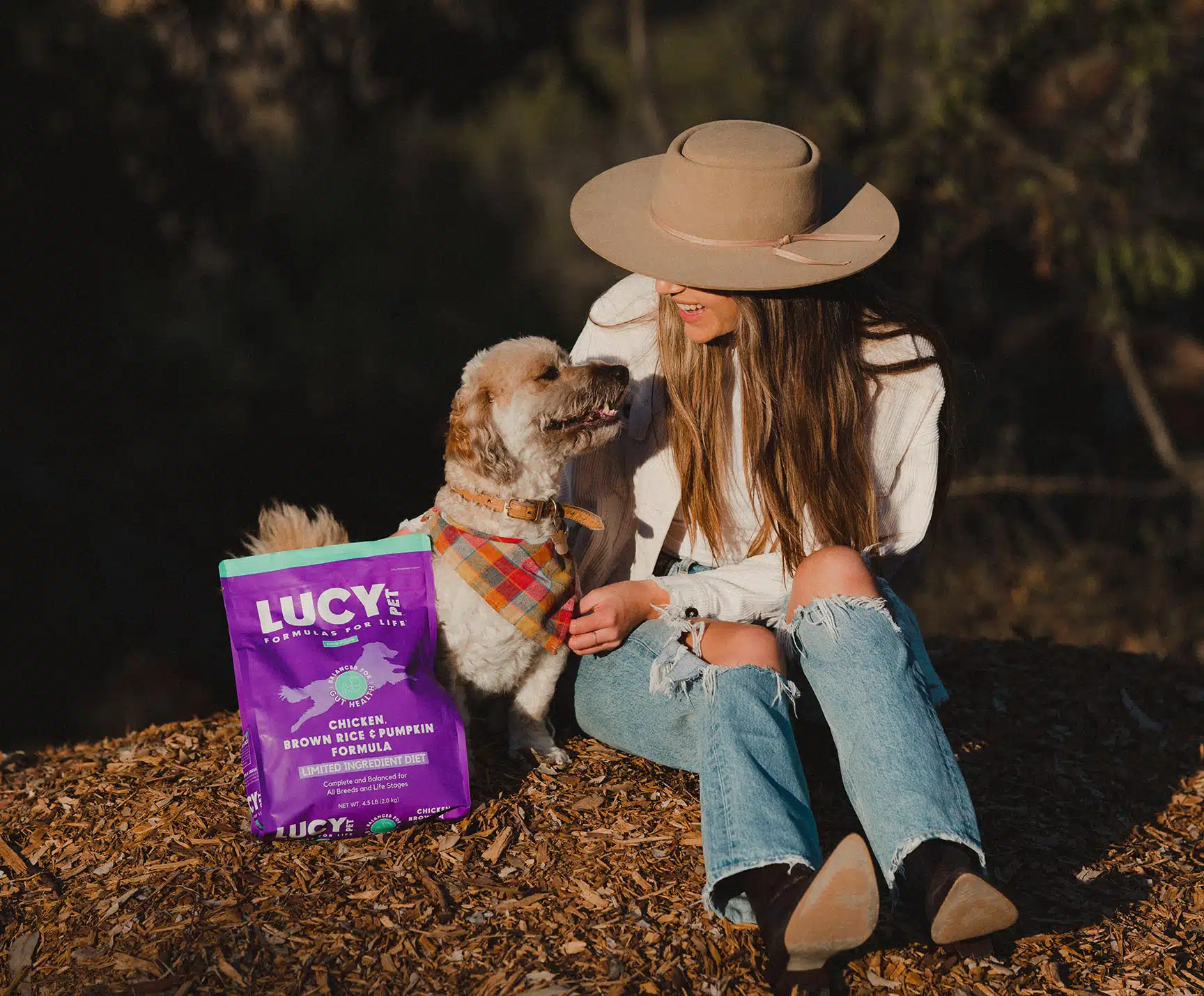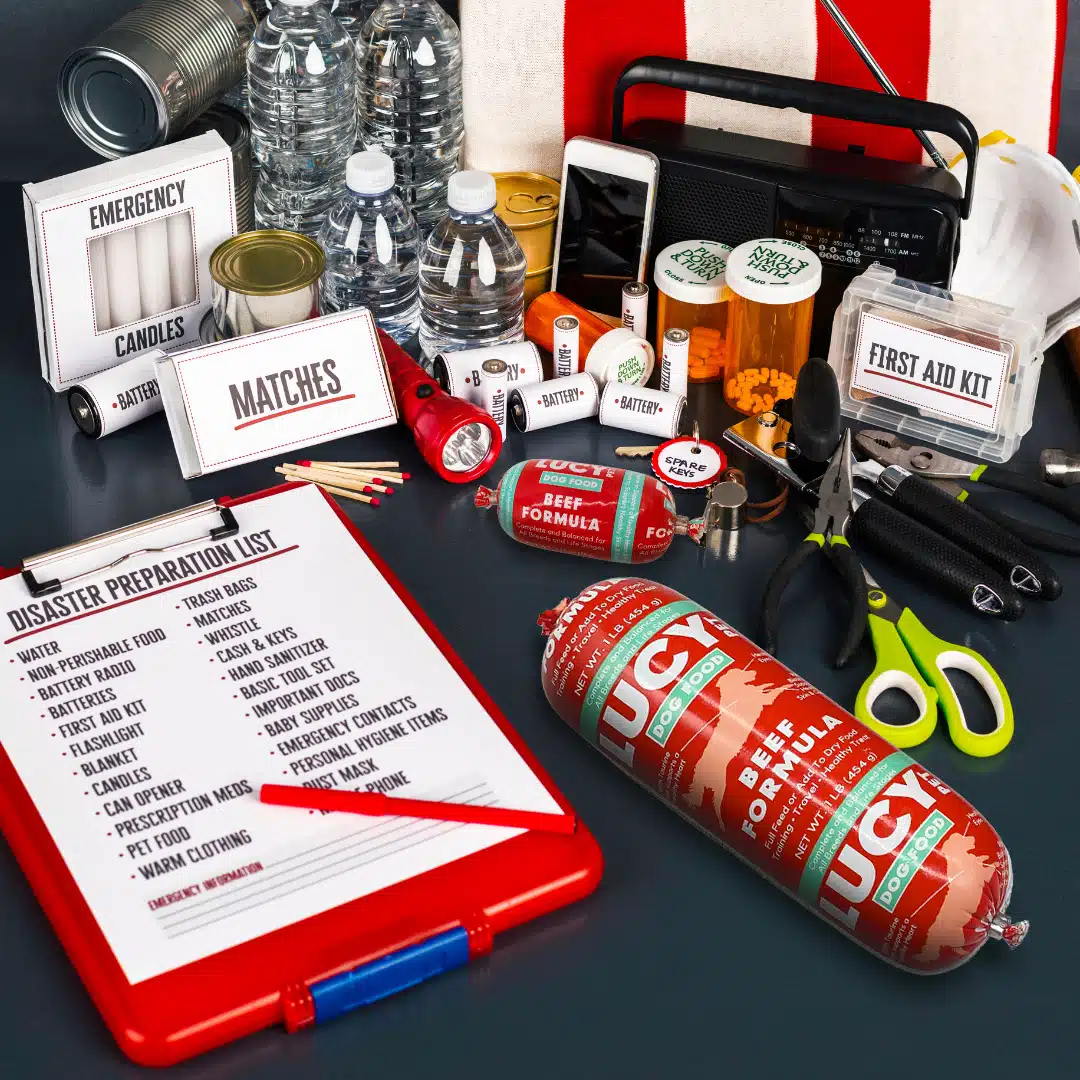An animal evacuation kit and first aid kit will help you to care for your animals in the event of a disaster. The evacuation kit should be assembled in an easy-to carry and watertight container. It should be stored in an easily accessible location away from areas with temperature extremes. Replace the food, water, and medications as often as needed to maintain their quality and freshness and according to expiration dates. Keep notes in the kit as to the location of medications that are stored elsewhere due to refrigeration needs. Consult your veterinarian for advice on making your kit for each individual animal. It’s important that you are familiar with the contents of your kit and their uses.
Assemble a disaster/evacuation kit for each dog and cat in the household

Store a one- to two-week supply of dry, rolls and/or canned food. Place dry food in airtight containers. Use the brand that your dog or cat normally eats. Food that can be stored and is easy to pack is one of the “Top 10 Items” to consider for your emergency kit. And here’s how our Dog Food Rolls come in – did you know that Lucy Pet™ Dog Food Rolls are ideal as a nutritious full feed dog food that can be stored at room temperature for up to 12 months? And there is no need to refrigerate Lucy Pet Rolls until they are opened. If you use canned food, buy the smallest size available as opened cans of food need to be stored in a refrigerator or ice chest. Bring a spoon, non-spill food dishes, can opener (sometimes flip lids don’t open properly), and plastic lids to put on open canned food. Record the diet and normal feeding amount and times for each animal, including what not to feed in case of allergies. Food should be replaced at least once every three to six months to prevent spoilage.
Bring a one- to two-week supply of water in plastic gallon jugs. A 40-pound dog needs roughly one gallon of water per day; a ten-pound cat needs one quart. Store water in a dark or shaded area that’s not in direct sunlight to avoid the growth of bacteria or algae, and be sure to change it every three to six months. Bring a sturdy, non-spill water dish and a small container of bleach for purification. To purify water, you can mix two drops of bleach to one quart of water. Mix and seal tightly for 30 minutes prior to drinking.
Bring a disinfectant cleaner to clean crates and litter boxes. Also bring paper towels, a pooper-scooper, plastic bags, newspaper, trash bags, and dish soap for cleaning food and water dishes.
If you have cats, bring a one- to two-week supply of scoopable litter stored in plastic jugs. Include a small plastic litter box and litter scoop. Bring plastic bags for disposing of scooped litter.
Have at least ten recent color pictures of all of your pets. This is in case you need to distribute them to shelters if your pets get lost. Be sure to include photos of any distinguishing features your pet may have. And make sure to update your pictures from time to time, especially if you have a puppy or kitten. Include yourself or other family members in the photos, as this is vital if you need to prove ownership. Store the pictures in a resealable plastic bag.
Make photocopies of important veterinary documents, including vaccination records (the types and dates), medical history, medical conditions, and medications. For dogs, keep a copy of your rabies certificate. Boarding facilities will require proof of current vaccinations including rabies, distemper, and bordetella for dogs. Keep records of important test results such as FeLV/FIV and heartworm as well as all medical conditions.
Have the name, address, and phone number of your veterinarian and an alternate veterinarian written legibly on a piece of paper. Write out a release statement authorizing emergency medical treatment for all of your pets. This is important in case you’re not available for approval during a disaster. Have your pet insurance policy number written down and keep a copy of your driver’s license as well as several waterproof marking pens.
List each pet separately and include dose and frequency of each medication. Be sure to keep a two-week reserve supply in your disaster kit along with directions on how to best administer. Be sure the medication doesn’t expire, and provide veterinary and pharmacy contact information for refills. For cats with hairball problems, be sure to include Laxatone or Petromalt.
Make copies of registration information, adoption papers, proofs of purchase, and microchip, tattoo, or other identification information. Keep a list of all dogs and cats and their species, breed, sex, color, age, and any special characteristics. Include their favorite hiding place and information on any special habits.
Your pet should wear a properly fitting collar and an ID tag at all times. This includes cats that never go outside. I recommend using a breakaway collar for cats. An extra collar or harness and leash, one for each pet, should be kept in the disaster kit as well as extra tags that you can personalize in case you have to move to a temporary location. For cats, include a properly fitting cat harness and leash so they can be safely controlled when outside of the crate. If your pet has a microchip implant—which I strongly recommend— be sure to include the national registry numbers in your kit. Also, make “lost cat/dog” signs with your phone number and address. Leave several blank lines to write in the animal’s description, where it was last seen, and any other pertinent information.
Have identification tags including license and rabies tags, if appropriate, for each of your pets. Tags should include your name, home address, a phone number where you can be reached, and an out-of-area phone number of someone with whom you will be in contact during or soon after the disaster/evacuation. If possible, include your veterinarian’s name, location, and phone number. Some of this information could be printed in indelible ink onto a piece of tape and affixed to the back of the tag.
Include brushes for both cats and dogs.
Bring familiar items to make pets feel comfortable, such as their blankets, beds, favorite toys, and treats. Bring extra booties or sweaters if appropriate.
Bring dry shampoo in case your pets need to be bathed, and towels for drying. Also, bring ear cleaning solution, nail clippers, muzzles, and appropriate flea, tick, and heartworm prevention. Pack dental cleaning supplies and hot water bottles.
 Each pet should have its own cage or carrier labeled with your contact information. All pet carriers should be in good condition with no missing parts or sharp edges. They should have the following information indelibly printed on them: your name, phone number, address, name, and description of your pet, any insurance policy number, and the address, and phone number of where you or a contact person can be reached if you’re not home. Never use cardboard carriers for cats because they’re not sturdy enough and cats can easily escape from them. Plastic crates should be large enough to hold a food and water dish and have enough room for your dog or cat to stand up and move around. For cats, the crate should be large enough to hold a small litter box as well. Be sure the carrier has a secure locking device. An alternative to a crate is a wire collapsible cage. These are better during warm weather because they provide better ventilation. For dogs, you should pack a spiral ground stake or tie out. These should be used cautiously, though, to avoid injury. Now is the time to get your pets used to their crates, especially cats (see chapter 7 for crate training).
Each pet should have its own cage or carrier labeled with your contact information. All pet carriers should be in good condition with no missing parts or sharp edges. They should have the following information indelibly printed on them: your name, phone number, address, name, and description of your pet, any insurance policy number, and the address, and phone number of where you or a contact person can be reached if you’re not home. Never use cardboard carriers for cats because they’re not sturdy enough and cats can easily escape from them. Plastic crates should be large enough to hold a food and water dish and have enough room for your dog or cat to stand up and move around. For cats, the crate should be large enough to hold a small litter box as well. Be sure the carrier has a secure locking device. An alternative to a crate is a wire collapsible cage. These are better during warm weather because they provide better ventilation. For dogs, you should pack a spiral ground stake or tie out. These should be used cautiously, though, to avoid injury. Now is the time to get your pets used to their crates, especially cats (see chapter 7 for crate training).
See chapter 8 for a list of items needed in your first aid kit. In addition to the kit, bring a thick pair of gloves or wildlife gloves for restraint if you have cats.
Be sure to pack solar-powered and battery-operated radios. Include a flashlight, extra batteries, and a cell phone and charger.
Assemble this list now before disaster strikes. Be sure to include addresses and 24-hour contact numbers if possible. This list can be used by rescue personnel responding to a disaster or by you during a disaster or an evacuation. Keep one copy near your telephone and one copy in your animal evacuation kit. Be sure to include a map of your local area and alternate evacuation routes in case of a road closure.
Make a list of the following contact information:
• Phone numbers and addresses where you may be reached
• You’re pre-arranged evacuation site
• Local contact person in case of emergency when you’re not available
• Out-of-state contact person in case the disaster is far-reaching in your locale
• Your veterinarian’s name, clinic address, and phone number
• Alternate veterinarian 30 to 90 miles away who provides boarding
• Local boarding facility
• Boarding facility 30 to 90 miles away
• Hotels/motels within a 90-mile radius that allow pets
• Local animal control
• Local police department
• Local fire department
• Local public health department
• Local animal shelter
• Local Red Cross chapter
• Local Humane Society
• Local Society for the Prevention of Cruelty to Animals (SPCA)
• United States Department of Agriculture Missing Pet Network
(www.missingpet.net)
By Karen “Doc” Halligan







Leave A Comment
You must be logged in to post a comment.